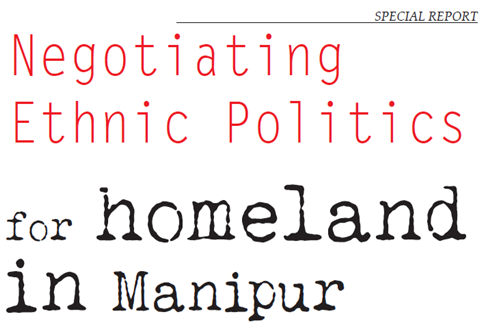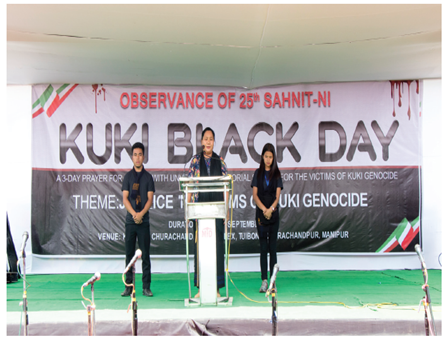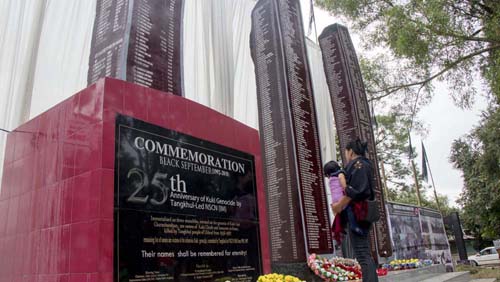
In the backdrop of the bohemian,surrounding the likelihood of one of the most potent insurgent groups of the Northeast region, NSCN IM or the Issak-Muivah faction of the Naga Socialist Council of Nagalim, finally concluding its peace deal with the government of India, after 21 years of ceasefire and several rounds of talks, on the basis of a framework agreement signed by the group’s Chief negotiator and Supremo, Thuingaleng Muivah and the government of India’s interlocutor, RN Ravi, in the presence of Prime Minister, Narendra Modi and Home Minister, Rajnath Singh on August 3rd 2015, the Kukis, the other tribal group, inhabiting the hills of Manipur are getting anxious with their own ethnic based homeland agenda and are using what it is called the ‘Kuki genocide for 1992-1997’ to get the better of the Nagas at the negotiating table.
NSCN (IM) has been pursuing the creation of a greater Nagaland by expanding the present map of the Nagaland state by including large areas of Assam adjoining Nagaland, Tirap, Longding and Changlang districts of Arunachal Pradesh, six hill districts of Manipur and parts of Myanmar. The proposed Greater Nagaland map of all contiguous Naga-inhabited areas is 7 times more in size than the present state of Nagaland, which covers only an area of 16,527 sq km. Even the Nagaland Assembly has endorsed the Greater Nagaland demand by integrating all naga-inhabited contiguous areas under one administration, as many as five times in December 1964, August 1970, September 1994, December 2003 and on July 27, 2015.
Kukis, through their militant groups, under two umbrella organizations, the KNO, the Kuki National Organization and the UPF, United People Front, are also engaged in political dialogue, negotiating for a Kuki homeland or territorial council under the constitution of India, after signing a Suspension of Operation (SoO) with the government of India and the government of Manipur since 2008.
the KNO, the Kuki National Organization and the UPF, United People Front, are also engaged in political dialogue, negotiating for a Kuki homeland or territorial council under the constitution of India, after signing a Suspension of Operation (SoO) with the government of India and the government of Manipur since 2008.
Historically, the Nagas and the Kukis have always fought over ownership of land. Recent rivalry over the control of land, specifically of the strategic, Indo-Myanmar border town of Moreh had even sparked off an ethnic clash in 1992 till 1997.
Upon losing control of Moreh to the Kukis, several Kuki villages and hamlets within the ‘naga areas’ (as claimed by the NSCN IM) were served quit notice and asked to leave the respective areas in the districts of Senapati, Ukhrul, Chandel and Tamenglong.
 Many saw in this campaign, the ultra motive to drive out all Kukis settlements out of the ‘naga areas’. Many equated it to ethnic cleansing and quit notice or not, barbaric killings of innocent villagers started. Soon casualties were on both sides and villagers voluntarily armed themselves to safeguard their villages. Kukis who were unprepared undoubtedly suffered more with several inhuman stories.
Many saw in this campaign, the ultra motive to drive out all Kukis settlements out of the ‘naga areas’. Many equated it to ethnic cleansing and quit notice or not, barbaric killings of innocent villagers started. Soon casualties were on both sides and villagers voluntarily armed themselves to safeguard their villages. Kukis who were unprepared undoubtedly suffered more with several inhuman stories.
The case of Joupi village may be a pointer to the dynamics of the ethnic conflict allegedly started by the NSCN IM towards fulfilling its design for a greater Nagalim. On September 13 in 1993, 108 innocent Kuki villagers were killed, mostly beheaded, allegedly by NSCN IM cadres, not sparing women and children. Every year the Kukis mourn the September 13 massacre by commemorating it as the ‘Sahnit Ni’ or the Black Day.
This year, the Kukis under the aegis of the Kuki INPI Manipur, the apex body of the Kukis in Manipur and KNO commemorated the ‘Sahnit In’ for three consecutive days from September 11 to September 13 in Churachandpur, the southern most district of Manipur which is generally regarded as a Kuki stronghold, mourning over a thousand of Kukis killed during what they called the infamous Kuki genocide of 1992-1997.
body of the Kukis in Manipur and KNO commemorated the ‘Sahnit In’ for three consecutive days from September 11 to September 13 in Churachandpur, the southern most district of Manipur which is generally regarded as a Kuki stronghold, mourning over a thousand of Kukis killed during what they called the infamous Kuki genocide of 1992-1997.
Unprecedented as it was, besides the usually hoisting of black flags in every Kuki homes in the entire state of Manipur and mass prayer services for the death, the homeless and the displaced, this year’s program included testimonies by survivors and unveiling of three memorial stones with all of the names of the death of the ‘Kuki genocide’, inscribed on them.
NguljahaoHangsing who was one of the survivor of the Joupi massacre, lived to tell the tale. He could have been the 89th person from Joupi village who were all butchered or hacked to death, including a woman, when they were fleeing from their village after a quit notice served on them on September 13 in 1993 in Tamenglong district.
Survivor Nguljahao who is marred with a deep sword scar on his neck recounted the ordeal of Joupi in which 88 innocent villagers were killed, one by one.
 “We were fleeing from our village that day, as they told us to vacate. While a group of us were going towards Tamei, NSCN IM cadres stopped us. They ordered us to lie down with our face down near a drain. As we laid, they tied our hands behind our back. After each of our hands were tied, all of us were again tied altogether so that no one could escape. Shortly, they started hacking one after another. I was on the other extreme and was hacked the last. I remembered losing consciousness. Thinking all of us were dead, they left. As they were leaving, I regained consciousness. I was bleeding profusely from my neck. I was trying to undo my hands when I hear one of our villagers calling out for his elder brother. His brother was among those butchered. I gathered strength and responded to his cry. This was how miraculously I was saved,” said NguljahaoHangsing from Joupi the village that saw the worst massacre of the ethnic conflict.
“We were fleeing from our village that day, as they told us to vacate. While a group of us were going towards Tamei, NSCN IM cadres stopped us. They ordered us to lie down with our face down near a drain. As we laid, they tied our hands behind our back. After each of our hands were tied, all of us were again tied altogether so that no one could escape. Shortly, they started hacking one after another. I was on the other extreme and was hacked the last. I remembered losing consciousness. Thinking all of us were dead, they left. As they were leaving, I regained consciousness. I was bleeding profusely from my neck. I was trying to undo my hands when I hear one of our villagers calling out for his elder brother. His brother was among those butchered. I gathered strength and responded to his cry. This was how miraculously I was saved,” said NguljahaoHangsing from Joupi the village that saw the worst massacre of the ethnic conflict.
Longkhosai, a senior villager from Joupi, who escaped the massacre, questioned why the government of India is not coming to aid the Joupi villagers who not only lost 88 villagers that day but also lost their homes, their fields and all their properties.
Sunzu Bachaspatimayum
To read the further article please get your copy of Eastern Panorama March issue @http://www.magzter.com/IN/Hill-Publications/Eastern-Panorama/News/ or mail to contact @easternpanorama.in


